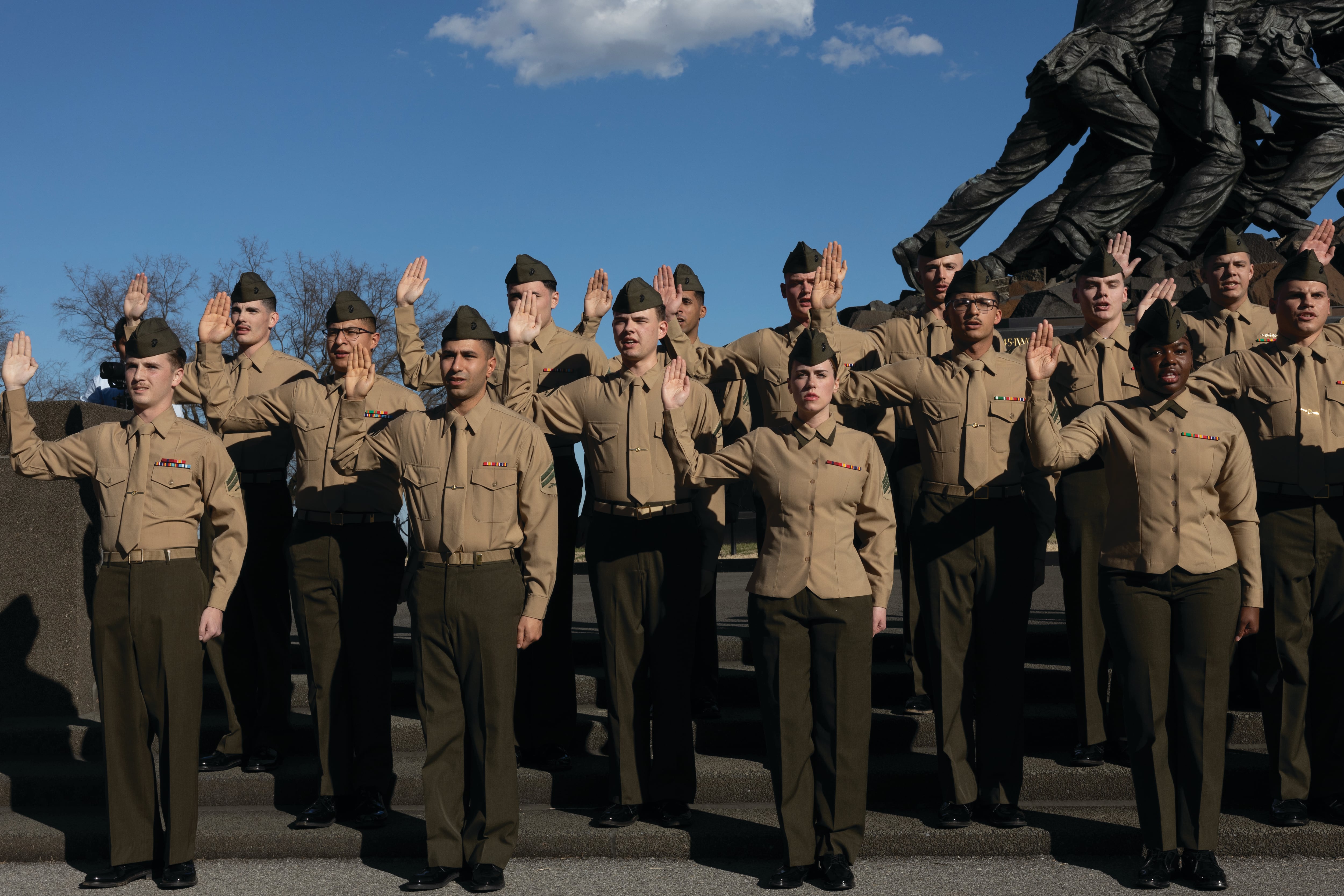One evening in 2016, John walked out of his career planner’s office carrying a blue-and-red folder that contained his completed reenlistment package. The junior enlisted Marine had a decision to make: Should he submit the package and stay in the Marine Corps, or leave the service the following year?
When John entered his workplace, his enlisted leaders greeted him by screaming at him for a “menial” mistake, something like forgetting to take out the trash or sweep properly.
“I was like, ‘Do I really want to subject myself to this for another four years?’” John recalled in a January interview with Marine Corps Times.
Once his leaders had left for the night, he chucked the folder in the trash.
John, now a Navy officer, spoke freely about his time in the military under the condition that Marine Corps Times not use his real name.
RELATED

Before the past few years, three quarters of enlisted Marines departed after one four-year term, as John did. Back then, the Marine Corps’ personnel model was to recruit young civilians, turn them into Marines, give them specialized training and churn most of them back out after four years.
But since 2021, the Corps has changed its approach.
It has thrown new bonuses and job options at enlisted Marines. It has tweaked its promotion policies to encourage reenlistments. It has promised long-term improvements to quality of life, albeit not many short-term fixes to the dire condition of the barracks.
The result? More and more Marines are opting to stay for second enlistments.
But the Marine Corps has room to grow in retention, according to Col. Eric Reid, the Corps’ head of manpower plans, programs and budget. It is not the case that the service has too many reenlistments on its hands.
“We’re a long way away from having that problem, although I would welcome that problem,” Reid told Marine Corps Times in January.
Even as more Marines sign on for second terms, lured in part by the Corps’ new focus on retention, many other Marines still — for a variety of reasons — decide to throw their reenlistment packages in the trash.

Some of the initiatives the Corps is pushing as a way to keep boosting retention will be expensive. Some will take a long time. Some may work, and some may not.
And the retention efforts hardly address what many Marine veterans say was a main reason they left: the indifferent, belittling or malicious treatment they received from some of their leaders.
The case for keeping Marines in
The Marine Corps already has seen a marked increase in the number of Marines who choose to stay.
In fiscal year 2020, the Marine Corps got 5,428 first-term enlisted Marines to reenlist, missing its goal by more than 300, according to data provided by Marine spokeswoman Capt. Sarah Eason.
But enlisted retention crept up in the ensuing years, and in fiscal year 2023 the Marine Corps aimed to have 6,225 first-term Marines reenlist. It overshot that goal, executing 7,079 first-term reenlistments.
The number of Marines choosing to reenlist after a second term in the service has modestly increased, according to the data.
Officer retention, however, has dropped, with 11% of officers leaving active duty in fiscal year 2023, compared to 8% in fiscal year 2019. Eason attributed that to the scrapping of some officer jobs, the military’s now-rescinded COVID-19 vaccine mandate and some officers delaying their separations until the economic uncertainties of the pandemic subsided. She said numbers are returning to pre-pandemic norms.
RELATED

The Marine Corps’ retention efforts aren’t about making everyone happy, Reid said.
“It’s about being ready to answer the nation’s call and to fight and prevail on battlefields we see going into the 2030s and 2040,” Reid said.
In preparing for conflict with a technologically sophisticated adversary, namely the Chinese military, the service has revamped the way it fights.
The Marines who would fire at enemy ships from temporary bases or spy on the enemy with drones or plan deliveries of food and fuel that can escape the enemy’s notice require plenty of training, Marine leaders have said.
When those Marines leave after four years, the Corps loses their expertise, and it has to spend time and money training their replacements, Reid said. By holding on to those Marines, the idea goes, the service can reduce those costs.
The Marine Corps unveiled the new focus on retention in November 2021, in a document called Talent Management 2030, which emphasized the need to keep experienced Marines who could undertake the complexities of modern war.
The document also made the case for a slightly older force, alluding to research that shows people are more physically and mentally fit in their mid-20s than in their late teens and early 20s.
Some observers say a focus on retention has its downsides.
Retired Col. Warren Parker warned in an October 2022 opinion piece in Marine Corps Times that an older force could be less eager to deploy and more expensive to sustain.
“A distinguishing characteristic of the Corps is, unlike the other services, we are a young, first term force eager for adventure and challenge,” Parker wrote.

The Marine Corps hasn’t engaged in a war with another great power in recent years, so it is hard to say for certain whether having a more experienced force will pay off on the battlefield, as the service predicts.
But the emphasis on retention has already helped the Marine Corps weather the recruiting difficulties that have battered the other services.
In fiscal year 2022, the Corps just barely met its recruiting goal — and only because it saw higher-than-expected retention that allowed it to lower its initial goal. It made its recruiting goal the following year, too, even as every other branch besides the Space Force came up short.
Yet Parker speculated in his op-ed that the emphasis on retention could indirectly hamper future recruitment efforts, since returning high numbers of young Marines to the civilian world as veterans “helps to maintain an important link to the American people.”
Managing talent
To boost retention, the Marine Corps is setting out to build a “retention climate,” Col. Bob McCarthy, branch head of Manpower Management Enlisted Assignments, told Marine Corps Times in January.
The Corps has tasked commanding generals with a mission to keep a certain number of their Marines, prompting them to prioritize retention, McCarthy said. Career planners have been speaking with Marines earlier in their terms about their reenlistment options.
Another key initiative is the Commandant’s Retention Program, which targets a few thousand of the top-performing first-term Marines annually, McCarthy said. Those Marines get a streamlined path to reenlistment and greater choice about their next duty station.
RELATED

Cpl. Walker Kerns, an F/A-18 ejection seat mechanic with the South Carolina–based Marine Fighter Attack Squadron 312, reenlisted in October 2023 through that program. He had planned to reenlist anyway, but he appreciated that he didn’t have to jump through any hoops to do so, he told Marine Corps Times in January.
“What that did is it allowed me to focus not only on my job, instead of primarily being focused on reenlisting, but it kind of secured my spot, so to speak,” Kerns said.
The Marine Corps also is offering earlier reenlistments and promotions, loosening the policy of kicking out Marines who twice fail to get promoted, and allowing more local assignment changes to decrease the number of disruptive moves. And it is making it easier for Marines to switch jobs, in a process called lateral moves.
“There are more opportunities in today’s Marine Corps for you to do the things that you want and for you to be good at,” McCarthy said.
But retired Col. James Van Riper told Marine Corps Times he takes issue with what he sees as the implication of Talent Management: that Marines need to be managed, rather than led.
“While Marine leaders may manage materials, equipment, budgets, etc., they necessarily lead Marines, for Marines are not inanimate objects to be dealt with in the same manner as budgets or the handling of materials and equipment,” he wrote via email in January.
Your bonus is that you get a bonus
One kind of reenlistment incentive the Corps is offering Marines is financial.
At a conference in February 2023, Gen. Eric Smith, now the Marine commandant, sparked outrage among Marines by remarking on the idea of paying bonuses to recruits: “Your bonus is that you get to call yourself a Marine.”
As the comment spread across social media, it often appeared shorn of the context about recruiting, such that many Marines seemed to think their assistant commandant was anti-bonus in all cases. Which, Smith maintained, was far from true.
“The Marines who have earned that eagle, globe and anchor, you’re not who I was talking to,” Smith, then the assistant commandant, told Marine Corps Times the day after that remark. “You, I want to give a bonus to.”
In fact, the Marine Corps is offering a host of retention bonuses. And it actually does give out recruitment bonuses for certain job fields.
RELATED

In 2024, infantrymen who reenlist can fetch a $27,000 reenlistment kicker, plus tens of thousands more depending on how much time they have served. Reenlisting air traffic controllers get $30,000. Several dozen other in-demand specialties rate reenlistment bonuses, too.
There are bonuses for Marines who stay on in the Reserve after active duty.
There are hefty kickers for Marines who switch into jobs like counterintelligence and drone operating.
There are pay bumps for recruiters and even greater pay bumps for those who agree to stay in that often thankless job for extra time.
Not all of these financial incentives are new. But the Marine Corps has increased its spending on special pay for enlisted Marines from $146 million in fiscal year 2017, or approximately $184 million in today’s dollars, to $214 million in fiscal year 2023, according to budget documents.
Yet paying people more money costs money — and to get money, the Marine Corps relies on Congress.
Congress sets standard base pay for troops across the services. For other kinds of pay, the Marine Corps is also to a large extent at the mercy of Congress.
Lawmakers haven’t yet passed the full budget for the fiscal year, leaving some of the financial incentives the Marine Corps has planned for in limbo, Reid said in January.
“We’re not able to move quite as quickly as we wanted to this year to fully execute,” the colonel said. “We’re mitigating the risk right now to our retention plan. … I think we’re going to find a way to adapt.”
Better barracks and chow — someday
Low pay, sluggish reenlistment processes and a lack of job choice are far from the only issues that have pushed good Marines to leave the Corps, Marine leaders have acknowledged.
The barracks, often known as “the bricks,” are 34 years old on average, according to Smith, and often in a sorry state. Mold is a persistent problem in the Corps’ barracks, as it is in other branches’ housing.
The service is planning some improvements to barracks management, maintenance and furniture in the short term. On Feb. 7, it announced a “wall-to-wall” inspection of every single barracks room and squad bay to assess the problems in the facilities.
But better barracks won’t come cheap or quickly.
The Marine Corps wants Congress to give it approximately $1.5 billion a year for barracks, up from $300 million a year, according to an internal memo obtained by Marine Corps Times. And it will take a decade to resolve the barracks problems, Smith said in October 2023.
RELATED

In the meantime, the Corps’ School of Infantry–East in North Carolina had to shut down a shower facility in December 2023 and send in a health inspector because of apparent black mold coating the ceiling. The following month, photos taken by a Marine at the West Coast infantry school revealed dead vermin and general disarray.
Corps leadership has an idea of what better barracks would look like.
Sergeant Major of the Marine Corps Carlos Ruiz posted an Instagram video in January showing off the glossy new barracks building for Marines at Naval Weapons Station Yorktown, Virginia.
These “barracks of the future,” as Ruiz called them, boast a gym, sleek lounge areas, in-room thermostats, walk-in closets and plenty of natural light.
“That’s where we want to get to,” Ruiz said.
The Marine Corps also sees food as an area it needs to improve if it wants to keep more Marines.

That could mean meal cards for Marines to use at a variety of on-base locations, Lt. Gen. James Glynn, deputy commandant for manpower and reserve affairs, told reporters in March 2023. The service also plans to invest in renovating its chow halls, Smith said the same month.
“In the future world of recruiting challenges, we cannot lose a 12-year intelligence professional or artillery Marine because we could not provide access to pediatric care or a high quality chow hall,” the Marine Corps warned that month in an update to its Talent Management 2030 plan.
‘Miss the clowns, not the circus’
After Marine Corps Times published a call for readers to weigh in for this story, more than 200 responses poured in, providing an unscientific overview of why Marines leave the service. Each told a unique story.
Some left because they lacked opportunities in their job fields, a problem the Marine Corps is now trying to counteract by offering more lateral moves, or they couldn’t get promoted. Some left because of medical issues, exacerbated by physical training and the Corps’ suck-it-up mentality.
Some left because they were disillusioned with the withdrawal from Afghanistan, the vaccine mandate or the introduction of women into infantry jobs. Some left because they faced discrimination on the basis of their race, sexuality or gender.
Some left because their spouses threatened them with divorce if they didn’t leave, and sometimes those spouses divorced them anyway. Some left because they hated being forced to serve as recruiters. Some left because they wanted to pursue full-time college or higher-paying jobs.
RELATED

But one theme emerged again and again: Lots of Marines left because they hated the way their leaders treated them.
Multiple veterans complained of “being treated like a child” and of “fuck-fuck games,” the colorful term describing the useless or nearly useless tasks that leaders sometimes force junior Marines to do. More than a dozen used the word “toxic” to describe their leadership.
These veterans said they left because of the gunnery sergeant who denied a Marine’s request to visit a dying grandmother, the second lieutenant who refused to promote a corporal who had romantic success with a certain woman they both liked, the sergeant major who yelled at Marines for there being too much dirt under the bushes by the barracks.
Many of the veterans who wrote to Marine Corps Times said they missed their peers but not their unit’s leaders: “miss the clowns, not the circus,” as one put it.
Back in 2021, the Marine Corps touted one new initiative as a way to prevent toxic leadership — to clean up the circus. The service said it would solicit reviews from leaders’ peers and subordinates, not just their supervisors, and incorporate that “360-degree feedback” into decisions about which leaders got promoted.
Then the Corps walked back that plan.
In May 2023, it unveiled a pilot program that would collect 360-degree feedback on a select group of leaders. But the feedback would be used only to help leaders “construct a development plan that leverages their identified strengths and addresses any blind spots.”
It wouldn’t factor into decisions about promotion decisions.
“When we began conducting our background research on how to execute a 360-degree review we identified incongruities with our objectives when used as an evaluation tool,” Marine spokesman Maj. Jordan Cochran said in a statement at the time. “These incongruities are not a concern when the tool is used strictly for development purposes.”
Ruiz, the top enlisted Marine, acknowledged in a January statement to Marine Corps Times that “leadership undoubtedly contributes to Marines’ plans in and out of service.”
But he said quality-of-life issues are at the forefront of what the Corps sees when it assesses separation trends.

“Marines made a promise to this nation that they will fight and win when called upon,” Ruiz said. “Their service cannot be taken for granted, and it’s our responsibility as leaders to provide quality care, quality living conditions and transparent leadership.”
Ruiz told Marine Corps Times on Jan. 31 that he benefited from good leaders who took the time to push him — an immigrant from Mexico who “came from nothing” — to try new things, to challenge himself.
“If that doesn’t happen during your time wearing a uniform, then you’re going to seek it somewhere else,” Ruiz said.
RELATED

John, who threw his reenlistment package into a trash can nearly eight years ago and recently became a Navy officer, said his time in the Marine Corps wasn’t all bad.
But he didn’t like the way higher-ranking Marines in his unit treated junior Marines: reluctant to take their ideas seriously, all too quick to punish them for small infractions.
He wants to make sure his sailors don’t face the kind of treatment that once discouraged him from reenlisting.
“The nonsense wears on people’s minds,” John said.
Kerns, the aircraft mechanic who reenlisted in 2023, said his leaders are one reason he is staying in.
Recently, even though his unit really needs him at work, leaders there let him spend three weeks at the Corporals Course, which he must complete in order to get promoted to sergeant. He saw that as them looking out for his career.
The Marine Corps has given him so much, the corporal said: strong values and interpersonal skills, leaders who support him, the chance to serve his country.
For Kerns, at least, the Marine Corps delivered on its promises. Now he wants to give back. ■
Irene Loewenson is a staff reporter for Marine Corps Times. She joined Military Times as an editorial fellow in August 2022. She is a graduate of Williams College, where she was the editor-in-chief of the student newspaper.





